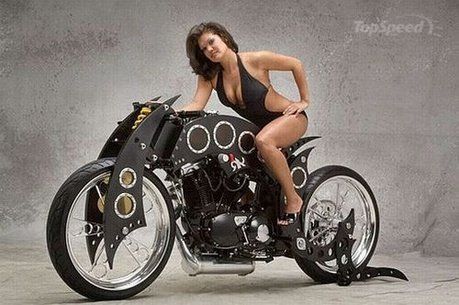
MOTOR CYCLE MONSTROSITIES
By H. O. Duncan.
"Picture to yourself a motor cycle fitted with four huge cylinders, long raking handle-bars, exaggerated petrol tanks, hideous silencers, etc., such as made its appearance to compete in the hill-climbing competition at Gaillon last season, not to speak of half a dozen other weird monsters of the same type and similar eccentricities, which also turned up on the same occasion. No one who has even an elementary knowledge of what a motor cycle should be imagines for an instant that the construction of machines of the above kind will help on the evolution of motor cycles for practical use...

The 1903 private purchaser will be in total ignorance of the monstrosity that in reality “did the trick,” but the manufacturer has obtained his point on the way of utilising a freak machine which no sensible man would ever purchase, to advertise his wares! In all probability the standard 1 3/4 h.p motor bicycle placed upon the market would not get halfway up the hill without the assistance of laborious pedalling, and in all probability would stick halfway The owner would have to dismount and push, or, possibly, call in the assistance of the small boys, who for a few pence “represent extra horse power for weak motorists” on Sundays and fete days!

Taking another view of the situation, what mechanical or commercial value can be placed upon these monstrosities, used as they are upon a straight mile or kilometre, or, what is an even worse test of their efficiency, upon the cemented racing paths. They certainly do harm to the sport, and even more to the pastime, from the mere fact that the spectators, seeing a motor bicycle, perchance for the first time, get quite a wrong impression as to what the ideal machine should in reality be for daily use and for touring purposes. The non-spectators or likely purchasers are apt to be led astray by “ficticious advertisements” which are often the outcome of these competitions. Such machines may produce a “new sport”, but no one can say such monstrosities used in competition do good to the industry in finding out “weak points” in the motor or in the machine, in order that the manufacturers may rectify the defects before the standard model is manufactured."

In those early days of motorcycle competition, engines were incredibly inefficient, as 'surface' and 'wick' carburetors, 'automatic' inlet valves, and spotty ignition timing, made for unreliable, slow, and highly flammable racers. Ixion, in 'Motor Cycle Reminiscences' (Iliffe, 1921), recounts how often indeed his Pioneer machines would catch fire, and even burn to the ground, due to an unexpected mingling of fuel vapors and loose sparks.

Racing rules in France and Austria (the only European countries which hosted races at that time) gave no restrictions on engine size; one way around a weak little engine is to incorporate a much bigger (albeit equally inefficient) motor into a motorcycle. During a beautiful period in those pre-1906 days, a free-for-all developed with designers throwing the most unlikely engines between two wheels. Cylinder capacities of over 1 liter EACH were not unheard of - these were steam engine dimensions, which of course, was the common currency of the day, as trains and boats were the first truly 'motorized' vehicles, using steam for motive power since the heady days of James Watt and Robert Fulton.

Ixion wrote: "The Parc de Princes track in Paris maintained a large programme of events, and men like Cissac [photos 3 and 5] thought nothing of evolving leviathan motorcycles, sometimes of 20hp. [4000cc] Occasionally two or three of these monsters would visit England, but our tracks were too gently banked for them...At this time [ca 1900] the French manufacturers and riders easily headed the industry." Racing on public roads was banned in England at this time, and not until the Brooklands track was completed in 1907 did any real race track exist in England. The French and Austrians held the major International competitions, which had incredible weight restrictions (ie, maximum weight of 108 or 120lbs!), thus forcing development of the racing machines in some very odd directions.

H.O. Duncan decried them as 'Monstrosities', setting a poor example for the public, and arguments such as this have altered the course of motorcycle evolution in the past 100 years in significant ways. When, in the course of racing development, designers have reached for extreme measures in the quest for advantage (ie, enhancements which bore no relationship with 'utility'), the forces of Rationality and Production-Based competition have raised the alarm and banned them. Thus, initially, engine capacity was restricted in racing to standardized formulas. In some areas, 'Works' machines were restricted - racing had to be conducted with 'same as you can buy' motorcycles. Then, as supercharging came to the fore, it was banned as well. When the number of cylinders grew to six and more in GP racing, restrictions on engine complexity were enacted. When the number of gears on lightweight racers reached 12 or more, gearboxes were limited to 6 ratios. Most recently, when the world no longer drove two-strokes, GP racing moved to four-stroke engines.

The impact of these 'corrections' was certainly felt in the design studios, and focussed the industry on the betterment of the Motorcycle per se. As the public justification for racing has always been to 'improve the breed', these restrictions have kept us true to our word at least (although we know that racing is fun regardless of any purported Greater Good!).

Of course, it wasn't just the French who built Monsters; the American Glenn Curtiss (above) installed an experimental 40hp (6,000cc) V-8 aircraft engine of his own make, into what may have been the earliest duplex-loop frame. In 1907, he took his shaft-drive machine to Ormond Beach in Florida, and clocked 136.8mph one-way, making him the fastest man in any vehicle at the time. The shaft broke on the return run, but Curtiss was satisfied, and in fact his record remained unbeaten for 23 years! The machine now sits in the Smithsonian Institution.

Dave Richmond from the Isle of Wight sent this article; he currently hosts 'The Engine Room' blog):
"Hi there, fellow motorcycle obsessive; while reading your blog mention of cycle pacers [in the Board Track Racing on Film post] I thought you might like the following, published in The Motor Cycle 105 years ago...I had the huge good fortune to write for The Motor Cycle in its final years, and developed a habit of photocopying articles that tickled my fancy. I'm now semi-retired and am collating them into what might become a book, or blog. I look forward to seeing the pics on your fine blog in due course, and would be happy to send you some more snippets. Like you, I was a regular visitor to Verralls many moons ago at the Tooting site. Happy days."
Thanks Dave!
Photo credits: Photo 1; from Aldo Carrer's wonderful 'The Dawn of the Motorcycle' - 1903, 'over 100km/h', Parc de Princes. Photo 2; from James Sheldon's 'Veteran and Vintage Motorcycles' (Transport Bookman, 1961), "A typical French small-track racer of 1902 with many interesting features. The ornament on the rider's waistcoat is the oiling system"! Photo 3; H. Cissac, July 27, 1905, 16hp (2500cc) Peugeot, 110lbs, 87.32mph. From Gerry Belton's 'All the Years at Brooklands' (Centenial, 2007). Photo 4; Marius The, 1903 Buchet racer; Marius raced from 1896 for Peugeot. From Ixion's
Motor Cycle Reminiscences'. Photo 5; Cissac on a Board Track in France, from Carrer. Photo 6; Carrer, cover shot from 'The Dawn of the Motorcycle' - Italy 1904, Count Dionigi Albertengo of Monasterolo, Turin. 12hp Marchand, top speed 124km/h. Photo 7; from Carrer; 'A French rider at a race in England' - same race as Marius The above.
Photo 8; artist's rendition of an early 'monster' race, from an old postcard put out by Continental Tires, 1921. Taken from 'Motorcycling Through History During the Golden Age of Postcards', Jerry Hooker, 2004. Photo 9; Glenn Curtiss postcard from 1907, same source as above. Photo 10; Reproduction Curtiss V-8 (you know you want one), from the Curtiss Museum website.








No comments:
Post a Comment